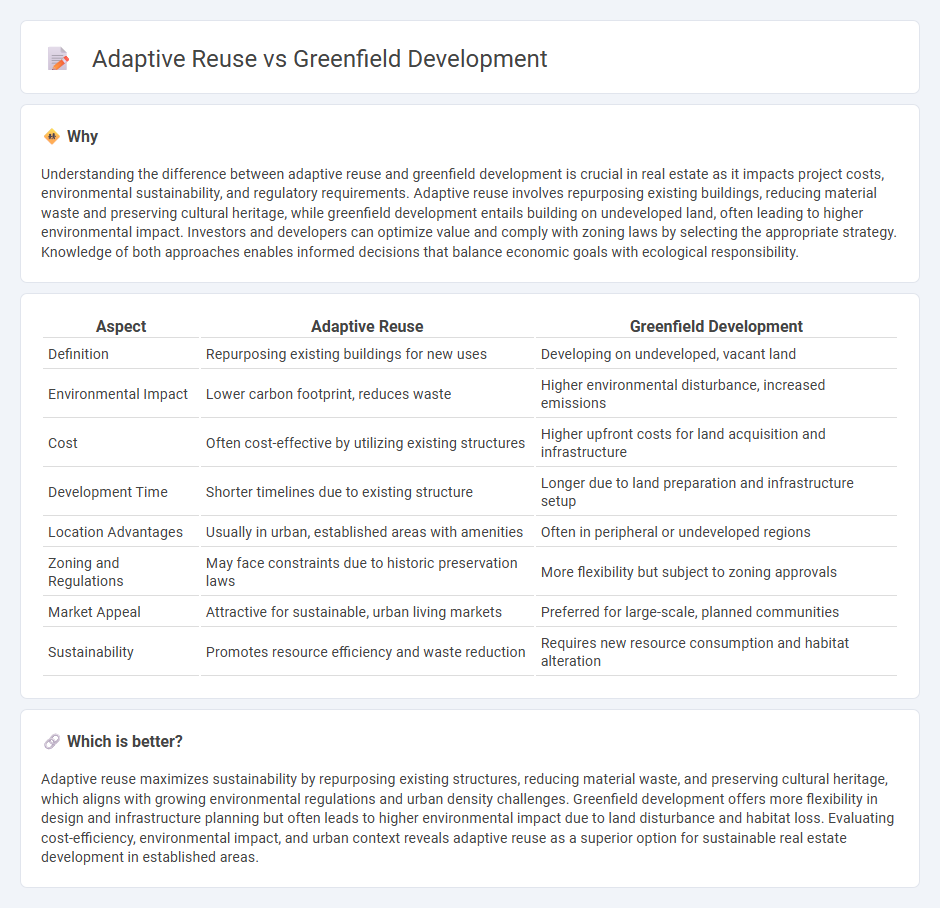
Adaptive reuse transforms existing buildings into functional spaces, reducing waste and preserving architectural heritage. Greenfield development involves constructing new structures on undeveloped land, offering customization but often impacting natural ecosystems. Explore the advantages and implications of each approach to determine the best fit for your real estate project.
Why it is important
Understanding the difference between adaptive reuse and greenfield development is crucial in real estate as it impacts project costs, environmental sustainability, and regulatory requirements. Adaptive reuse involves repurposing existing buildings, reducing material waste and preserving cultural heritage, while greenfield development entails building on undeveloped land, often leading to higher environmental impact. Investors and developers can optimize value and comply with zoning laws by selecting the appropriate strategy. Knowledge of both approaches enables informed decisions that balance economic goals with ecological responsibility.
Comparison Table
| Aspect | Adaptive Reuse | Greenfield Development |
|---|---|---|
| Definition | Repurposing existing buildings for new uses | Developing on undeveloped, vacant land |
| Environmental Impact | Lower carbon footprint, reduces waste | Higher environmental disturbance, increased emissions |
| Cost | Often cost-effective by utilizing existing structures | Higher upfront costs for land acquisition and infrastructure |
| Development Time | Shorter timelines due to existing structure | Longer due to land preparation and infrastructure setup |
| Location Advantages | Usually in urban, established areas with amenities | Often in peripheral or undeveloped regions |
| Zoning and Regulations | May face constraints due to historic preservation laws | More flexibility but subject to zoning approvals |
| Market Appeal | Attractive for sustainable, urban living markets | Preferred for large-scale, planned communities |
| Sustainability | Promotes resource efficiency and waste reduction | Requires new resource consumption and habitat alteration |
Which is better?
Adaptive reuse maximizes sustainability by repurposing existing structures, reducing material waste, and preserving cultural heritage, which aligns with growing environmental regulations and urban density challenges. Greenfield development offers more flexibility in design and infrastructure planning but often leads to higher environmental impact due to land disturbance and habitat loss. Evaluating cost-efficiency, environmental impact, and urban context reveals adaptive reuse as a superior option for sustainable real estate development in established areas.
Connection
Adaptive reuse transforms existing buildings into functional spaces, reducing urban sprawl and preserving architectural heritage, which complements Greenfield development by balancing new construction on undeveloped land with sustainable urban regeneration. Both strategies address housing demand and commercial needs while promoting environmental sustainability through efficient land use and resource conservation. Integrating adaptive reuse with greenfield projects optimizes real estate assets, minimizes ecological impact, and supports smart growth in urban planning.
Key Terms
Land Acquisition
Greenfield development involves acquiring undeveloped land, often resulting in higher costs and longer permitting processes due to zoning and environmental assessments. Adaptive reuse capitalizes on existing structures, reducing land acquisition expenses and streamlining development timelines by utilizing previously acquired property. Explore how strategic land acquisition choices impact project feasibility and sustainability in urban planning.
Zoning Regulations
Zoning regulations play a crucial role in delineating the feasibility of greenfield development versus adaptive reuse, often restricting land use intensity and building types in established urban areas. Greenfield projects benefit from fewer legacy constraints, allowing more flexible design and higher density, whereas adaptive reuse must comply with existing zoning codes that might limit modifications to preserve historical and architectural integrity. Explore how local zoning policies impact these development strategies to optimize land use and urban renewal.
Environmental Impact
Greenfield development often leads to increased environmental degradation due to habitat disruption, loss of green spaces, and higher carbon emissions from new construction activities. Adaptive reuse significantly reduces environmental impact by repurposing existing structures, minimizing waste and demand for raw materials while preserving cultural heritage. Explore detailed comparisons to understand how both approaches align with sustainable urban planning goals.
Source and External Links
What Is Greenfield Development? | Planopedia - Planetizen - Greenfield development refers to real estate projects built on previously undeveloped land, offering fewer regulatory and community constraints and requiring new infrastructure installation such as streets and utilities.
A Guide to Greenfield Development (2023) - Transect - Greenfield development involves developing on blank-slate land, generally allowing faster project timelines, lower costs, and flexibility compared to brownfield sites which may have contamination and zoning challenges.
Greenfield project - Wikipedia - Greenfield projects are new developments with no constraints from prior construction, allowing architectural flexibility and use of latest technology, but often entail higher capital costs and longer schedules due to infrastructure development.
 dowidth.com
dowidth.com